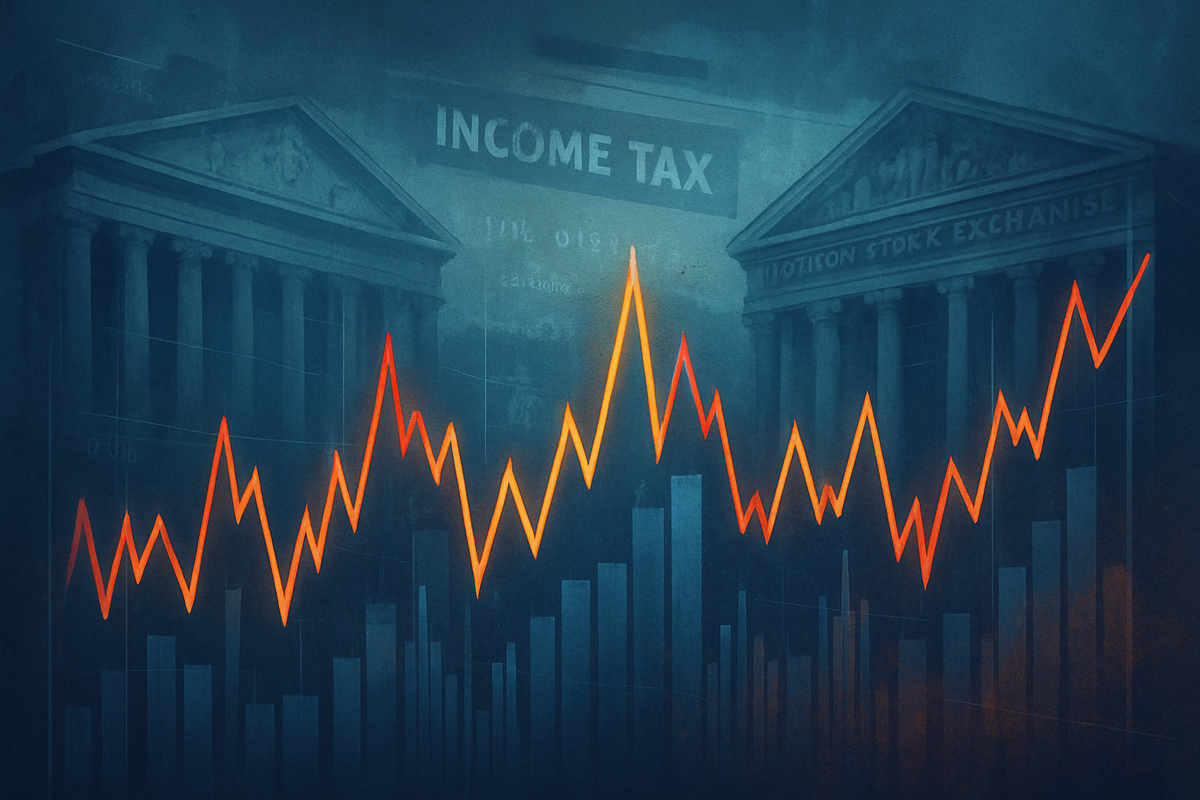
London, UK – November 14, 2025 – The United Kingdom's financial markets are experiencing a turbulent period, marked by significant volatility following unexpected reports concerning Chancellor Rachel Reeves' income tax plans. Just weeks ahead of the crucial Autumn Budget on November 26, 2025, news has emerged of a dramatic U-turn on previously anticipated income tax rate increases. Instead, the government is reportedly set to extend the freeze on income tax thresholds for an additional two years, a move that has sent ripples through the gilt market, weakened the pound sterling, and sparked investor uncertainty regarding the nation's fiscal direction. This sudden policy pivot underscores the delicate balance the government is attempting to strike between fiscal responsibility, political pledges, and economic stability.
A Sudden Shift: The Income Tax U-Turn and Its Immediate Aftermath
The current market agitation stems from widespread reports on November 14, 2025, indicating that Chancellor Rachel Reeves has abandoned plans to directly increase income tax rates. For weeks, there had been strong signals and even "careful planning" within government circles for a potential hike in income tax, possibly by as much as 2p, to address a substantial fiscal deficit, which some estimates had placed between £30 billion and £40 billion. However, a last-minute reversal of this strategy has materialized.
Instead of raising headline income tax rates, the government has reportedly opted to extend the freeze on income tax thresholds for an additional two years, likely until April 2030. This measure, a continuation of "fiscal drag," is estimated to generate approximately £7.5 billion in revenue by pulling more individuals into paying income tax or into higher tax brackets as their nominal wages rise with inflation.
The immediate implications for UK markets were stark:
- Gilt Market Sell-off: UK government bonds, or gilts, experienced a sharp sell-off. The yield on 10-year gilts, a key benchmark for government borrowing costs, jumped by 12 to 13 basis points, reaching levels around 4.55% to 4.57%, a four-week high. Yields on 30-year gilts also saw a significant spike, indicating an increased cost of borrowing for the government.
- Pound Sterling Weakness: The value of the pound sterling briefly fell against major currencies, dropping approximately 0.5% against the US dollar and the euro.
- Stock Market Decline: The UK's benchmark FTSE 100 index traded down by 1.1% to 1.3%, with the more domestically focused FTSE 250 index also experiencing a downturn.
- Investor Uncertainty: The abrupt policy shift fueled investor unease and raised questions about the UK government's fiscal credibility and its long-term strategy for managing public finances. All eyes are now firmly fixed on the Chancellor's Autumn Budget on November 26, 2025, for clarity on how the remaining fiscal gap will be addressed.
The Policy Reversal: Details, Timeline, and Key Players
The dramatic shift in income tax policy has unfolded rapidly, culminating in today's reports. For several weeks leading up to the Autumn Budget, Chancellor Rachel Reeves had strongly hinted at the necessity of significant tax increases, including a potential income tax hike, to address a substantial fiscal "black hole" and demonstrate fiscal responsibility. These proposed increases would have directly challenged a core Labour Party 2024 election manifesto pledge not to raise income tax rates.
However, reports on November 14, 2025, confirmed a U-turn, with the Chancellor scrapping plans to directly increase income tax rates. This decision was reportedly made on Wednesday, November 12, following critical discussions between Chancellor Reeves and Prime Minister Keir Starmer.
Several factors are cited as drivers for this policy reversal:
- Improved Fiscal Outlook: Updated forecasts from the Office for Budget Responsibility (OBR) reportedly indicated that the fiscal shortfall was significantly smaller than previously anticipated, closer to £20 billion rather than the earlier £30-35 billion. This improvement was attributed to better-than-expected data on wage growth and subsequent increased tax revenue forecasts.
- Political Pressure and Manifesto Pledges: There was significant internal pressure from senior Labour Members of Parliament and a desire to adhere to the party's 2024 election manifesto pledge not to increase income tax rates on working people. Breaking this promise was seen as politically perilous, especially given public opposition to such hikes, as revealed by recent YouGov polling.
Key players involved in this unfolding situation include:
- Chancellor of the Exchequer Rachel Reeves: The architect of the UK's fiscal policy and the central figure in this U-turn.
- Prime Minister Keir Starmer: Reportedly involved in the high-level discussions leading to the policy reversal.
- The Treasury: The government department responsible for economic and financial policy.
- Office for Budget Responsibility (OBR): Whose updated forecasts provided crucial data influencing the Chancellor's decision.
- Labour Party MPs: Whose "concerted pressure" played a significant role in the avoidance of a direct tax rate hike.
- Financial Markets and Investors: Who reacted immediately to the uncertainty, reflecting concerns over fiscal credibility.
The initial market reactions underscored deep-seated concerns: 10-year gilt yields rose by 0.13 percentage points to 4.57%, and the pound weakened by 0.4% against the dollar. The FTSE 100 index fell by 1.6%, with analysts warning of a "bloodbath for the gilt market" and a "doom loop scenario" if clarity on fiscal plans isn't provided.
Companies Navigating the Fiscal Current: Potential Winners and Losers
The UK government's nuanced income tax policy decisions present a complex landscape for public companies. While the direct hike in income tax rates has been averted, the extended freeze on income tax thresholds is set to significantly impact consumer disposable income through "fiscal drag," creating a distinct divide between potential winners and losers.
Potential Losers:
Companies heavily reliant on UK consumer spending for non-essential goods and services are likely to face significant headwinds due to reduced real disposable income.
- Domestically Focused Consumer Discretionary Businesses: This includes retailers in fashion, electronics, and home improvement. Examples include Kingfisher Plc (LSE: KGF), Wickes Group Plc (LSE: WIX), Next Plc (LSE: NXT), Currys, AO World, WH Smith, and Pets at Home.
- Hospitality and Leisure Sector: Pubs, restaurants, hotels, and domestic tourism operators are particularly vulnerable. This sector also faces rising operating costs from increased employer National Insurance Contributions (NICs) and reduced business rates relief from April 2025. Companies like Domino's Pizza, JD Wetherspoon, Rank Group, and Wizz Air could see reduced demand.
- Import-Reliant Businesses: A weaker pound, observed after the U-turn reports, could increase import costs, further eroding profit margins for retailers and businesses dependent on international supply chains.
Potential Winners:
Conversely, certain sectors and companies may find themselves in a more favorable position.
- Multinational Companies with Significant Overseas Earnings: Companies that generate a substantial portion of their revenues in foreign currencies may benefit from a weaker sterling, as their overseas profits translate into a higher sterling value when converted back to pounds.
- Export-Oriented Businesses: A weaker pound makes UK exports more competitive globally. Examples include pharmaceutical giant GlaxoSmithKline (LSE: GSK), food and retail conglomerate AB Foods (LSE: ABF), industrial valve maker Rotork (LSE: ROR), information services company Experian (LSE: EXPN), and global caterer Compass Group (LSE: CPG).
- Defensive Sectors / Essential Goods Retailers: Companies providing essential goods and services are generally more resilient. Large supermarkets like Tesco Plc (LSE: TSCO) and J Sainsbury Plc (LSE: SBRY) may see shifts towards value offerings but are less impacted than discretionary sectors.
- Discount Retailers: As real incomes are squeezed, consumers often trade down, which could benefit discount chains and value-oriented retailers.
- Companies Benefiting from Corporate Tax Stability: The UK Corporate Tax Roadmap, with a corporation tax capped at 25% and continued full expensing of capital investment, remains favorable for engineering and manufacturing mid-caps.
Wider Significance: Fiscal Drag and Market Credibility
The Chancellor's U-turn and the extended freeze on income tax thresholds represent a significant moment in the UK's fiscal policy, fitting into a broader trend of governments utilizing "fiscal drag" to raise revenue without explicitly hiking tax rates. This approach becomes particularly potent in an environment of high inflation and wage growth, where individuals are pushed into higher tax brackets even if their real income growth is stagnant.
The ripple effects are far-reaching:
- Consumer Spending: The reduction in real disposable income for individuals, particularly middle-income earners, will likely dampen consumer spending, impacting businesses in retail and services.
- Labor Market: The increased tax burden could affect incentives to work more or seek promotions, exacerbating the "60 per cent tax trap" for some earners.
- Fiscal Credibility: The market's negative reaction to the U-turn underscores concerns about the government's fiscal credibility and its ability to manage public finances transparently. This unpredictability can deter investment.
- Other Revenue-Raising Measures: To compensate for the abandoned income tax rate hike and the remaining fiscal shortfall, the Chancellor is expected to introduce other measures, potentially including abolishing the salary sacrifice scheme for pension contributions and a new tax on electric vehicles.
- Impact on Pensioners: With the state pension set to rise, the continued freeze on the personal allowance means more pensioners could be pushed into paying income tax for the first time.
Historically, "fiscal drag" has been a consistent revenue raiser, but the current prolonged period of high inflation amplifies its impact. The Office for Budget Responsibility (OBR) previously estimated that earlier freezes would create millions of new taxpayers and higher-rate taxpayers. This latest extension will further intensify that trend, highlighting the ongoing tension between a government's desire to meet fiscal rules, adhere to political pledges, and manage public perception of tax burdens.
What Comes Next: Navigating Uncertainty
The path forward for UK markets and the economy is characterized by ongoing adaptation and uncertainty.
Short-Term Possibilities: The immediate aftermath of the U-turn has seen currency weakness, a gilt sell-off, and equity market declines, reflecting investor concerns about fiscal credibility and a lack of clear direction. This uncertainty could lead to "decision paralysis" for UK businesses and potentially delay anticipated interest rate cuts by the Bank of England, tightening financial conditions for an already sluggish economy (GDP growth of 0.1% in Q3 2025).
Long-Term Possibilities: The government will likely continue to rely on a "messy patchwork of smaller, economy-damaging tax increases" to close the fiscal gap, leading to persistent policy uncertainty. The extended fiscal drag will continue to squeeze real disposable incomes, potentially dampening consumer spending and contributing to subdued economic growth. Prolonged fiscal uncertainty could deter long-term investment.
Potential Strategic Pivots or Adaptations Required:
- For the Government: The Chancellor is expected to pursue a "smorgasbord" of alternative revenue-raising measures in the upcoming Budget, including further threshold freezes, targeted tax hikes (e.g., on salary sacrifice pension schemes, electric vehicles), and potential tweaks to Capital Gains Tax (CGT) and Inheritance Tax. Rebuilding fiscal credibility through clear communication will be paramount.
- For Businesses: Proactive tax planning, intensified cost management, diversification of revenue streams, and embracing innovation will be crucial. Utilizing existing incentives like the Annual Investment Allowance and R&D tax credits remains important.
- For Individuals: Careful financial planning, particularly regarding pensions and investments, will be necessary to navigate the impact of fiscal drag and potential reforms to tax-free lump sums or CGT.
Market Opportunities and Challenges: Challenges include a persistent fiscal credibility deficit, reduced consumer demand, investment hesitancy due to uncertainty, and sector-specific headwinds from new targeted taxes. Opportunities may arise from targeted government incentives for specific sectors, investments in digital transformation and innovation, and growth in ESG (Environmental, Social, and Governance) related industries.
Potential Scenarios: Analysts are considering a "muddle through" scenario as most likely, where the government uses piecemeal tax adjustments to meet fiscal rules without resolving underlying uncertainty. A "gilt crisis" remains a tail risk, and a "stagflationary outcome" (sluggish growth, persistent inflation, rising unemployment) is also a concern. There is also the possibility that the significant fiscal shortfall could eventually force the government to reconsider and introduce more radical tax changes.
Wrap-Up: A Market at a Crossroads
The UK's financial markets find themselves at a crossroads following the Chancellor's income tax U-turn and the decision to extend the freeze on income tax thresholds. This pivotal moment underscores the complex interplay of economic necessity, political expediency, and market confidence.
Key Takeaways:
- The abandonment of direct income tax rate hikes, while politically expedient, has created immediate market volatility and raised questions about fiscal transparency.
- The extended freeze on income tax thresholds represents a significant, long-term shift in personal taxation, incrementally increasing the tax burden on a broader segment of the population through "fiscal drag."
- Initial market reactions, including rising gilt yields and a weakening pound, reflect investor anxiety over the government's fiscal credibility and its ability to articulate a clear, sustainable economic strategy.
Assessment of the Market Moving Forward: The market will likely remain sensitive to fiscal policy announcements. The reliance on "stealth taxes" through fiscal drag, while generating revenue, risks eroding consumer purchasing power and potentially dampening economic activity. The government's challenge will be to find alternative, less disruptive ways to fill the remaining fiscal gap without further unsettling investors or hindering growth.
Significance and Lasting Impact: This policy pivot highlights the intense pressures on the government to balance its books while adhering to political promises. The lasting impact could be a prolonged period of "fiscal drag," where households face a gradually increasing tax burden. For the government, this strategy provides consistent revenue but risks public discontent and a perception of opacity in tax policy. Economists warn that without more substantial and clear plans, the government might resort to a "haphazard patchwork of smaller anti-growth tax increases," potentially damaging credibility and long-term economic prospects.
What Investors Should Watch For: In the coming months, investors should closely monitor:
- The Autumn Budget (November 26, 2025): The full details of the government's fiscal strategy, including any further revenue-raising measures beyond the threshold freeze, will be critical.
- Gilt Market Stability: Continued volatility or sustained high borrowing costs for the government will signal ongoing market apprehension.
- Inflation and Wage Growth: These indicators will determine the severity of "fiscal drag" and its impact on household disposable income.
- Consumer Spending Data: Trends in retail sales and consumer confidence will reveal the real-world impact of reduced purchasing power.
- Political Stability and Policy Cohesion: Any further signs of internal government dissent or policy reversals could exacerbate market uncertainty.
This content is intended for informational purposes only and is not financial advice





